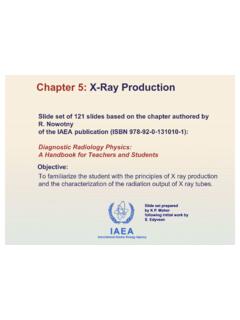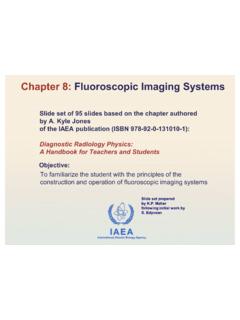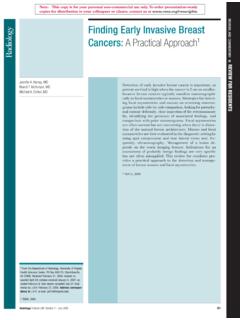Transcription of Chapter 6: Basic radiation detectors
1 IAEA International Atomic Energy Agency Set of 60 slides based on the Chapter authored by VAN EIJK Faculty of Applied Sciences, Delft University of Technology, Delft, Netherlands of the IAEA publication (ISBN 978 92 0 143810 2): Nuclear Medicine Physics: A Handbook for Teachers and Students Objective: To familiarize the student with the fundamental concepts of Basic radiation detectors Chapter 6: Basic radiation detectors Slide set prepared in 2015 by J. Schwartz (New York, NY, USA) IAEA Chapter 6 TABLE OF CONTENTS Introduction Gas filled detectors Semiconductor detectors Scintillation detectors and storage phosphors Nuclear Medicine Physics: A Handbook for Teachers and Students Chapter 6 Slide 2/60 IAEA INTRODUCTION radiation detectors complexity and relevance radiation detectors are of paramount importance in nuclear medicine The detectors provide a wide range of information including.
2 radiation dose of a laboratory worker Positron emission tomography (PET) image of a patient Consequently, detectors with strongly differing specifications are used Nuclear Medicine Physics: A Handbook for Teachers and Students Chapter 6 Slide 3/60 IAEA INTRODUCTION Interaction mechanisms, signal formation and detector type radiation detectors Sensors that produce signals upon interaction with radiation Signals can be processed electronically to give requested information X-rays & -rays interaction mechanisms Photoelectric effect Compton scattering Pair production Relative importance depends on radiation energy Interaction medium Result in production of energetic electrons These will eventually transfer their energy to interaction medium by ionization and excitation Nuclear Medicine Physics.
3 A Handbook for Teachers and Students Chapter 6 Slide 4/60 IAEA INTRODUCTION Interaction mechanisms, signal formation and detector type Charged particles transfer their energy by ionization & excitation ionization results in Charge carriers production: Electrons and ions in a gaseous detection medium Electrons and holes in a semiconductor material Light quanta emission in scintillators radiation detectors Charge or current forms signal Signal created by charge motion in applied electric field Gas filled detectors Semiconductor detectors Light emission observed using light sensor that produces charge or current Scintillation detectors Nuclear Medicine Physics.
4 A Handbook for Teachers and Students Chapter 6 Slide 5/60 IAEA INTRODUCTION Counting, current, integrating mode Radiology / radiotherapy radiation detectors Operated in current mode Intensities too high for individual counting of events Nuclear medicine Primarily use counting mode Energy information Arrival time information Personal dosimeters Detector used in integrating mode Dose is measured monthly Information extracted much later after actual interaction Nuclear Medicine Physics: A Handbook for Teachers and Students Chapter 6 Slide 6/60 IAEA INTRODUCTION Detector requirements radiation detector quality expressed in terms of Sensitivity Energy resolution Time and position resolution Counting rate performance Nuclear Medicine Physics: A Handbook for Teachers and Students Chapter 6 Slide 7/60 IAEA INTRODUCTION Detector requirements Sensitivity Sensitivity depends on Subtended solid angle Detector efficiency for radiation interaction Relevant energy range is ~30 511 keV, where it s governed by.
5 Photoelectric effect Attenuation length (cm) ~ Zeff3 4 = density, Zeff = effective atomic number of the compound Compton scattering Almost independent of Z Proportional to of gas-filled detector is 3 orders of magnitude smaller than for solid state detector Need highest possible and Zeff at 511 keV Nuclear Medicine Physics: A Handbook for Teachers and Students Chapter 6 Slide 8/60 IAEA INTRODUCTION Detector requirements Energy, time and position resolution Energy resolution Strongly coupled to number of information carriers Number of information carriers Given by N = E/W E = radiation energy W = Mean energy needed to produce information carrier Largest number produced in semiconductors Smallest number produced in inorganic scintillators + PMT s Nuclear Medicine Physics.
6 A Handbook for Teachers and Students Chapter 6 Slide 9/60 IAEA INTRODUCTION Detector requirements Energy, time and position resolution Detector type W (eV) Gas filled (electron ion) 30 Semiconductor (electron hole) 3 Inorganic scintillator (light quantum) 25 Inorganic scintillator + PMT (electron) 100 Inorganic scintillator + Si diode (electron hole pair) 35 Mean energies W to produce information carriers Nuclear Medicine Physics: A Handbook for Teachers and Students Chapter 6 Slide 10/60 IAEA INTRODUCTION Detector requirements Energy, time and position resolution Energy resolution definition: E = FWHM N = E/W N = 2=FN F = Fano factor Gas-filled detectors F = Semiconductors F Scintillator F = 1 = =Nuclear Medicine Physics.
7 A Handbook for Teachers and Students Chapter 6 Slide 11/60 IAEA INTRODUCTION Detector requirements Energy, time and position resolution Time resolution Mainly important for PET in nuclear medicine Time resolution depends on 2 main factors Rise time of the signal pulses Height of the signal pulses Important because there is also noise Easier to determine pulse position when the pulse is higher relative to noise Time jitter due to pulse height (energy) variation is less important Inorganic Scintillators detectors preferred because they have Fast response Fast rise time Light sensors fast response Nuclear Medicine Physics: A Handbook for Teachers and Students Chapter 6 Slide 12/60 IAEA INTRODUCTION Detector requirements Energy, time and position resolution Position resolution Most easily obtained by pixelating detector at pitch corresponding to requested resolution In nuclear medicine, important in.
8 Gamma camera /SPECT PET detection systems Use of monolithic scintillator blocks recently studied Light detection by pixelated sensors Analogous to gamma camera Broad light distribution measured using pixels smaller than centre of the distribution Resolution better than the pixel size Nuclear Medicine Physics: A Handbook for Teachers and Students Chapter 6 Slide 13/60 IAEA INTRODUCTION Detector requirements Counting rate and dead time Achievable counting rate depends on Detector response time Time to transport charge carriers to form signal Time to emit the scintillation light Time needed to process the signals Time needed to handle the data Nuclear Medicine Physics.
9 A Handbook for Teachers and Students Chapter 6 Slide 14/60 IAEA INTRODUCTION Detector requirements Counting rate and dead time Non-paralysable detectors Second event t < Not counted Second event t > Counted DT fixed at T = true event rate R = counting rate R = Fraction of time system is dead TR = rate of loss of events = T R Dead time (DT): Minimum time between true events at which these are counted separately TTR+=1 Nuclear Medicine Physics: A Handbook for Teachers and Students Chapter 6 Slide 15/60 IAEA INTRODUCTION Detector requirements Counting rate and dead time Paralysable detectors Second event t < not counted DT extended from time of second event 3rd event at t > after 1st event & within after 2nd event not counted DT extended another DT is not fixed Can become >> extendable dead time Counted: event which occurs at t > Counting rate = rate of occurrences of time intervals > between events TTR =eNuclear Medicine Physics.
10 A Handbook for Teachers and Students Chapter 6 Slide 16/60 IAEA INTRODUCTION Detector requirements Counting rate and dead time Relation between R and T for non-paralysable and paralysable cases if = 0, than R = T Nuclear Medicine Physics: A Handbook for Teachers and Students Chapter 6 Slide 17/60 IAEA GAS FILLED detectors Basic principles Energetic electrons Produce secondary electrons travelling through gas Secondary electrons drift to anode & ions to cathode The mode of operation depends on applied voltage (V) Nuclear Medicine Physics: A Handbook for Teachers and Students Cha






